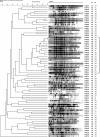Risk factors for efflux pump overexpression in fluoroquinolone-resistant Escherichia coli
- PMID: 22966123
- PMCID: PMC3475638
- DOI: 10.1093/infdis/jis567
Risk factors for efflux pump overexpression in fluoroquinolone-resistant Escherichia coli
Abstract
Background: We conducted a case-control study to identify risk factors for efflux overexpression, an important mechanism of fluoroquinolone resistance, among patients with fluoroquinolone-resistant Escherichia coli (FQREC) gastrointestinal tract colonization.
Methods: Three annual fecal surveillance surveys were performed hospital-wide, and all patients colonized with FQREC (levofloxacin minimum inhibitory concentration, ≥8 μg/mL) were included in the study. Cases and controls were defined on the basis of overexpression of the AcrAB efflux pump, as measured by the organic solvent tolerance (OST) assay. A multivariable logistic regression model was developed to identify risk factors for OST positivity among patients with FQREC colonization.
Results: Eighty-nine patients were colonized with FQREC: 44 (49.4%) and 45 (50.6%) patients had isolates that were OST-positive and OST-negative, respectively. On multivariable analyses, location on the surgical service was significantly associated with recovery of an OST-positive isolate (odds ratio, 7.36; 95% confidence interval, 1.82-29.7; P = .005). Furthermore, patients who had received a first-generation cephalosporin in the 30 days prior to sampling were less likely to have an OST-positive isolate (odds ratio, 0.20; 95% confidence interval, .04-.94; P = .04).
Conclusions: Among phenotypically identical FQREC isolates, different factors may drive the emergence of different resistance mechanisms. Further studies are needed to elucidate the relationship between antimicrobial use and specific resistance mechanisms.
Figures
Similar articles
-
Impact of antibiotic use during hospitalization on the development of gastrointestinal colonization with Escherichia coli with reduced fluoroquinolone susceptibility.Infect Control Hosp Epidemiol. 2013 Oct;34(10):1070-6. doi: 10.1086/673155. Epub 2013 Aug 23. Infect Control Hosp Epidemiol. 2013. PMID: 24018924 Free PMC article.
-
Gastrointestinal tract colonization with fluoroquinolone-resistant Escherichia coli in hospitalized patients: changes over time in risk factors for resistance.Infect Control Hosp Epidemiol. 2009 Jan;30(1):18-24. doi: 10.1086/592703. Infect Control Hosp Epidemiol. 2009. PMID: 19046057 Free PMC article.
-
Temporal changes in resistance mechanisms in colonizing Escherichia coli isolates with reduced susceptibility to fluoroquinolones.Diagn Microbiol Infect Dis. 2013 Aug;76(4):491-6. doi: 10.1016/j.diagmicrobio.2013.04.018. Epub 2013 May 27. Diagn Microbiol Infect Dis. 2013. PMID: 23719087 Free PMC article.
-
Phenotypic and genotypic characterization of fecal Escherichia coli isolates with decreased susceptibility to fluoroquinolones: results from a large hospital-based surveillance initiative.J Infect Dis. 2006 Jul 1;194(1):79-85. doi: 10.1086/503046. Epub 2006 May 31. J Infect Dis. 2006. PMID: 16741885
-
Defining relatedness in studies of transmission of antimicrobial-resistant organisms: variability in definitions across studies and impact of different approaches on study conclusions.Infect Control Hosp Epidemiol. 2013 Jan;34(1):40-8. doi: 10.1086/668780. Epub 2012 Nov 21. Infect Control Hosp Epidemiol. 2013. PMID: 23221191 Free PMC article. Review.
Cited by
-
Impact of antibiotic use during hospitalization on the development of gastrointestinal colonization with Escherichia coli with reduced fluoroquinolone susceptibility.Infect Control Hosp Epidemiol. 2013 Oct;34(10):1070-6. doi: 10.1086/673155. Epub 2013 Aug 23. Infect Control Hosp Epidemiol. 2013. PMID: 24018924 Free PMC article.
-
Association of overexpression of efflux pump genes with antibiotic resistance in Pseudomonas aeruginosa strains clinically isolated from urinary tract infection patients.J Antibiot (Tokyo). 2015 Sep;68(9):568-72. doi: 10.1038/ja.2015.34. Epub 2015 Apr 8. J Antibiot (Tokyo). 2015. PMID: 25850341
-
Fluoroquinolone consumption and Escherichia coli resistance in Japan: an ecological study.BMC Public Health. 2019 Apr 23;19(1):426. doi: 10.1186/s12889-019-6804-3. BMC Public Health. 2019. PMID: 31014305 Free PMC article.
-
Effect of six fluoroquinolones on the expression of four efflux pumps in the multidrug resistant Escherichia coli isolates.World J Microbiol Biotechnol. 2015 Jul;31(7):1041-8. doi: 10.1007/s11274-015-1854-x. Epub 2015 Apr 9. World J Microbiol Biotechnol. 2015. PMID: 25854862
-
Clinical and molecular epidemiology of Escherichia coli sequence type 131 among hospitalized patients colonized intestinally with fluoroquinolone-resistant E. coli.Antimicrob Agents Chemother. 2014 Nov;58(11):7003-6. doi: 10.1128/AAC.03256-14. Epub 2014 Sep 8. Antimicrob Agents Chemother. 2014. PMID: 25199782 Free PMC article.
References
-
- Neuhauser MM, Weinstein RA, Rydman R, Danziger LH, Karam G, Quinn JP. Antibiotic resistance among gram-negative bacilli in US intensive care units: implications for fluoroquinolone use. JAMA. 2003;289:885–8. - PubMed
-
- Linder JA, Huang ES, Steinman MA, Gonzales R, Stafford RS. Fluoroquinolone prescribing in the United States: 1995 to 2002. Am J Med. 2005;118:259–68. - PubMed
-
- Lautenbach E, Metlay JP, Bilker WB, Edelstein PH, Fishman NO. Association between fluoroquinolone resistance and mortality in Escherichia coli and Klebsiella pneumoniae infections: the role of inadequate empirical antimicrobial therapy. Clin Infect Dis. 2005;41:923–9. - PubMed
-
- Lautenbach E, Strom BL, Nachamkin I, et al. Longitudinal trends in fluoroquinolone resistance among Enterobacteriaceae isolates from inpatients and outpatients, 1989–2000: differences in the emergence and epidemiology of resistance across organisms. Clin Infect Dis. 2004;38:655–62. - PubMed
Publication types
MeSH terms
Substances
Grants and funding
LinkOut - more resources
Full Text Sources
Medical


